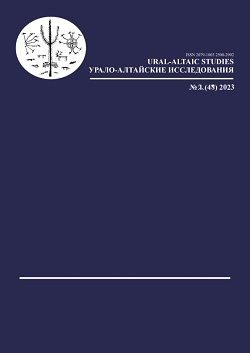Якутские обозначения младенца и основные стратегии номинации новорожденного ребенка в тюркских языках
Nomination Strategies for ‘Newborn’ in Turkic Languages and Other Words for ‘Baby’ in Yakut
Author(s): Idaliya V. Fedotova, Alena K. Prokopieva, Anastasia E. Shamaeva, Aitalina V. TimofeevaSubject(s): Lexis, Semantics, Turkic languages
Published by: Институт языкознания Российской академии наук
Keywords: the Yakut language; Turkic languages; semantic shift; nomination strategies; colour terms; red; words for ‘baby’;
Summary/Abstract: From a typological perspective, it is valuable to study ways of coding the meaning ‘baby’ in the languages of the world. The concepts ‘baby’ and ‘newborn baby’ do not belong to any semantic field that has been widely studied on the material of various languages of the world (kinship terms, aquamotion verbs, verbs of falling, temperature terms, colour terms), hence almost no comparative literature. Additionally, the semantic component ‘baby’ can be included in the broader lexical meaning ‘child’. Moreover, in the dictionaries of poorly studied and insufficiently described languages, words for different stages of a child’s growth and development up to one year are not recorded. This discrepancy begs the question of to what extent different languages code the reality in an even way: in some languages, researchers have recorded separate designations of a newborn baby, an infant, crawling, starting to walk, and in other languages they are still unknown. This study offers a new overview of all semantic models associated with labelling a baby under the age of one year in the Yakut language. Yakut words for a newborn child are examined on the Turkic background and compared with other languages of the world. 12 semantic models for ‘baby’ have been found: ‘red’, ‘new’ + ‘born’, borrowing ‘new, fresh’, ‘sticky, slippery’, ‘immature’, intensifier ‘water’, ‘getting dry’, ‘making certain sounds’, ‘in the cradle’, ‘breast’ (= ‘with breast’), boorowed word for ‘baby’ > ‘a baby who can sit’, ‘movement method’ > ‘toddler’. A possible explanation for the semantic shift ‘red’ > ‘newborn’ is proposed. The semantic models for ‘newborn’ among the Turkic languages are also observed, with the following source meanings: ‘raw’, ‘new’ + ‘born’, ‘red’. Some parallels in world languages are also considered.
Journal: Урало-алтайские исследования
- Issue Year: 2023
- Issue No: 02 (49)
- Page Range: 96-111
- Page Count: 16
- Language: Russian

